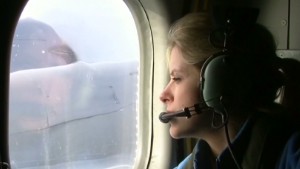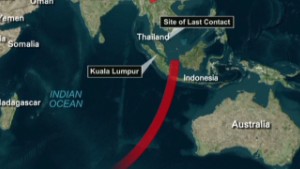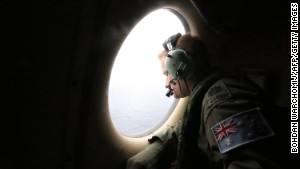 An Australian navy ship steamed Monday night toward the remote spot in the Indian Ocean where a surveillance plane earlier spotted two objects that could be related to missing Malaysia Airlines Flight 370.
An Australian navy ship steamed Monday night toward the remote spot in the Indian Ocean where a surveillance plane earlier spotted two objects that could be related to missing Malaysia Airlines Flight 370.
One object is "a grey or green circular object," and the other is "an orange rectangular object," the Australian Maritime Safety Authority said.
The reports have once again raised hopes of meaningful progress in the hunt for the plane, which has gone on for more than two weeks. Flight 370 vanished over Southeast Asia on March 8 during a flight from Kuala Lumpur, Malaysia, to Beijing. On board were 227 passengers and 12 crew.
Experts urged restraint.
"The fact that it's got color is really intriguing," said Colleen Keller, a senior analyst with Metron Inc., a defense contractor that helped with the search for Air France Flight 447. "But I've got to caution everybody, there's a lot of junk out there."
 A look inside the search for MH370
A look inside the search for MH370
 Source: Flight 370 turned, dropped
Source: Flight 370 turned, dropped
 Two objects located in ocean
Two objects located in ocean
 A look inside the search for MH370
A look inside the search for MH370  Source: Flight 370 turned, dropped
Source: Flight 370 turned, dropped  Two objects located in ocean
Two objects located in ocean
The objects are the latest in a series of sightings, including "suspicious objects" reported earlier Monday by a Chinese military plane that was involved in search efforts in the same region, authorities said.
So far, nothing has been definitively linked to Flight 370.
Malaysian Prime Minister Najib Razak's office said on Twitter that he would make a statement at 10 p.m. (10 a.m. ET). It was unclear what he planned to say.
Earlier, Hishammuddin Hussein, Malaysia's acting transportation minister, said only that "at the moment, there are new leads but nothing conclusive."
A reporter on board the Chinese plane for China's official Xinhua news agency said the search team saw "two relatively big floating objects with many white smaller ones scattered within a radius of several kilometers," the agency reported Monday.
The Chinese plane was flying at 33,000 feet on its way back to Australia's west coast when it made the sighting, the Australian Maritime Safety Authority said.
But a U.S. Navy P-8 Poseidon aircraft, one of the military's most sophisticated reconnaissance planes, that was tasked to investigate the objects was unable to find them, the authority said.
With the search in its third week, authorities have so far been unable to establish where exactly the missing plane is or why it flew off course from its planned journey from Kuala Lumpur to Beijing.
China has a particularly large stake in the search: Its citizens made up about two-thirds of the 227 passengers on the missing Boeing 777. Beijing has repeatedly called on Malaysian authorities, who are in charge of the overall search, to step up efforts to find the plane.
Malaysian and Australian authorities appeared to be more interested Monday in the two objects spotted by a Royal Australian Air Force P-3 Orion aircraft.
The Australian's navy's HMAS Success "is on scene and is attempting to locate the objects," the Australian maritime authority said.
Hishammuddin said Australian authorities had said the objects could be retrieved "within the next few hours, or by tomorrow morning at the latest."
Satellites focus search
Recent information from satellites identifying objects in the water that could be related to the plane has focused search efforts on an area roughly 1,500 miles southwest of the Australian city of Perth.
A total of 10 aircraft -- from Australia, China the United States and Japan -- were tasked with combing the search area Monday.
The aerial searches have been trained on the isolated part of ocean since last week, when Australia first announced that satellite imagery had detected possible objects that could be connected to the search.
Since then, China and France have said they also have satellite information pointing to floating debris in a similar area. The Chinese information came from images, and the French data came from satellite radar.
But Australian officials have repeatedly warned that the objects detected in satellite images may not turn out to be from the missing plane -- they could be containers that have fallen off cargo ships, for example.
On Saturday, searchers found a wooden pallet as well as strapping belts, Australian authorities said. The use of wooden pallets is common in the airline industry, but also in the shipping industry.
Hishammuddin said Monday that Flight 370 was carrying wooden pallets, but that there was so far no evidence they are related to the ones sighted in the search area.
The investigation into the passenger jet's disappearance has already produced a wealth of false leads and speculative theories. Previously, when the hunt was focused on the South China Sea near where the plane dropped off civilian radar, a number of sightings of debris proved to be unrelated to the search.
Plane said to have flown low
The sighting of the objects of interest by the Chinese plane came after a weekend during which other nuggets of information emerged about the movements of the errant jetliner on the night it vanished.
Military radar tracking shows that after making a sharp turn over the South China Sea, the plane changed altitude as it headed toward the Strait of Malacca, an official close to the investigation into the missing flight told CNN.
The plane flew as low as 12,000 feet at some point before it disappeared from radar, according to the official. It had reportedly been flying at a cruising altitude of 35,000 feet when contact was lost with air traffic control.
The sharp turn seemed to be intentional, the official said, because executing it would have taken the Boeing 777 two minutes -- a time period during which the pilot or co-pilot could have sent an emergency signal if there had been a fire or other emergency on board.
Authorities say the plane didn't send any emergency signals, though some analysts say it's still unclear whether the pilots tried but weren't able to communicate because of a catastrophic failure of the aircraft's systems.
The official, who is not authorized to speak to the media, told CNN that the area the plane flew in after the turn is a heavily trafficked air corridor and that flying at 12,000 feet would have kept the jet well out of the way of that traffic.
Malaysia disputes reprogramming
Also over the weekend, Malaysian authorities said the last transmission from the missing aircraft's reporting system showed it heading to Beijing -- a revelation that appears to undercut the theory that someone reprogrammed the plane's flight path before the co-pilot signed off with air traffic controllers for the last time.
That reduces, but doesn't rule out, suspicions about foul play in the cockpit.
Last week, CNN and other news organizations, citing unnamed sources, reported that authorities believed someone had reprogrammed the aircraft's flight computer before the sign-off.
CNN cited sources who believed the plane's flight computer must have been reprogrammed because it flew directly over navigational way points. A plane controlled by a human probably would not have been so precise, the sources said.
Malaysian authorities never confirmed that account, saying last week that the plane's "documented flight path" had not been altered.
On Sunday, they clarified that statement further, saying the plane's automated data reporting system included no route changes in its last burst, sent at 1:07 a.m. -- 12 minutes before the last voice communication with flight controllers.
Analysts are divided about what the latest information could mean. Some argue it's a sign that mechanical failure sent the plane suddenly off course. Others say there are still too many unknowns to eliminate any possibilities.
CNN aviation analyst Miles O'Brien called the fresh details about the flight a "game changer."
"Now we have no evidence the crew did anything wrong," he said. "And in fact, now, we should be operating with the primary assumption being that something bad happened to that plane shortly after they said good night."
If a crisis on board caused the plane to lose pressure, he said, pilots could have chosen to deliberately fly lower to save passengers.
"You want to get down to 10,000 feet, because that is when you don't have to worry about pressurization. You have enough air in the atmosphere naturally to keep everybody alive," he said. "So part of the procedure for a rapid decompression ... it's called a high dive, and you go as quickly as you can down that to that altitude."
Authorities have said pilot Zaharie Ahmad Shah was highly experienced. On Monday, Malaysian authorities said Flight 370 was co-pilot Fariq Abdul Hamid's sixth flight in a Boeing 777, and the first time when he was not traveling with an instructor pilot shadowing him.
"We do not see any problem with him," said Malaysia Airlines CEO Ahmad Jauhari Yahya.
Flight makes emergency landing
Adding to the negative publicity that has blighted Malaysia Airlines since news of Flight 370's disappearance, one of the carrier's passenger jets made an emergency landing in Hong Kong on Monday.
The plane, scheduled to fly from Kuala Lumpur to Incheon, South Korea, was diverted to Hong Kong after its main electrical generator stopped working. Electrical power continued to be supplied by the plane's auxiliary power unit, Malaysia Airlines said
The Airbus A330-300 landed safely at Hong Kong airport around 3 a.m., and the 271 passengers on board were transferred onto flights with other airlines.
No comments:
Post a Comment